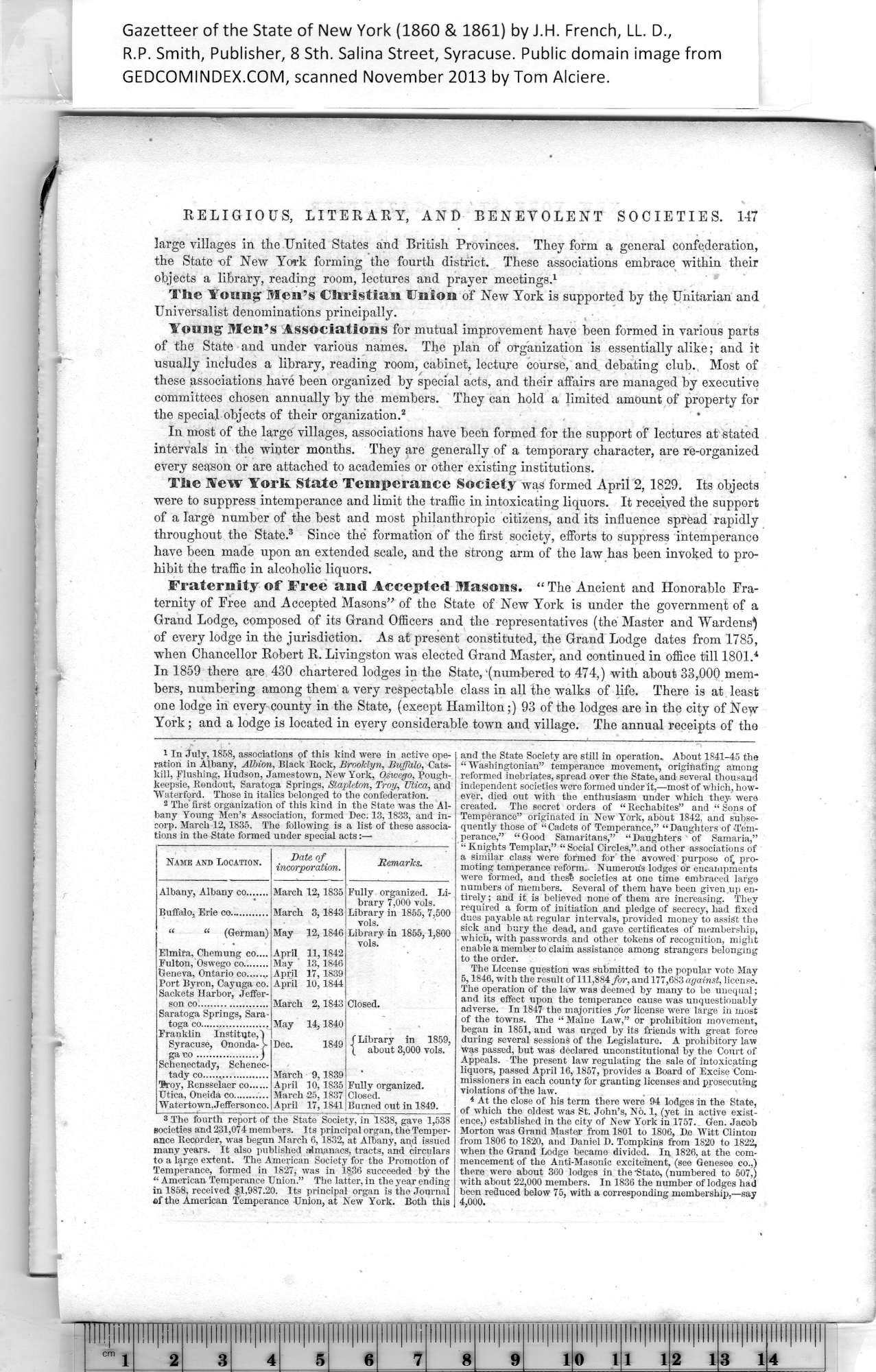|
Name and Location.
1 In July, 1858, associations of this kind were in active ope¬
ration in Albany, Albion, Black Kock, Brooklyn, Buffalo, Cats¬
kill, Flushing, Hudson, Jamestown, New York, Ostoego, Pough¬
keepsie, Rondout, Saratoga Springs, Stapleton, Troy, Utica, and
Waterford. Those in italics belonged to the confederation.
2 The' first organization of this kind in the State was the Al¬
bany Young Men’s Association, formed Dec. 13,1833, and in¬
corp. March 12,1835. The following is a list of these associa¬
tions in the State formed under special acts:—
Albany, Albany co-
Buffalo, Erie co.......
“ “ (German)
Elmira, Chemung co....
Fulton, Oswego co........
Geneva, Ontario co ..
Port Byron, Cayuga co.
Sackets Harbor, Jeffer¬
son co.....................
Springs, Sara-
Franklin Institute,)
Syracuse, Ononda- >-
gaco...................J
Schenectady, Schenec¬
tady co .............
l*roy, Rensselaer co......
Utica, Oneida co...........
Watertown, Jefferson co.
3 The fourth report of the State Society, in 1838, gave 1,538
societies and 231,074 members. Its principal organ, the Temper¬
ance Recorder, was begun March 6,1832, at Albany, and issued
many years. It also published almanacs, tracts, and circulars
to a large extent. The American Society for the Promotion of
Temperance, formed in 1827, was in 1836 succeeded by the
“ American Temperance Union.” The latter, in the year ending
in 1858, received $1,987.20. Its principal organ is the Journal
of the American Temperance Union, at New York. Both this
|
Remarks.
Fully organized. Li¬
brary 7,000 vols.
Library in 1855, 7,500
vols.
Library in 1855,1,800
vols.
Closed.
(Library in 1859,
( about 3,000 vols.
Fully organized.
Closed.
Burned out in 1849. |
and the State Society are still in operation- About 1841-45 the
“Washingtonian” temperance movement, originating among
reformed inebriates, spread over the State, and several thousand
independent societies were formed under it,—most of which, how¬
ever, died out with the enthusiasm under which they were
created. The secret orders of “ Rechabites” and “ Sons of
Temperance” originated in New York, about 1842, and subse¬
quently those of “ Cadets of Temperance,” “ Daughters of -Tem¬
perance,” “Good Samaritans,” “Daughters of Samaria,”
“ Knights Templar,” “ Social Circles,” and other associations of
a similar class were formed for’ the avowed purpose of) pro¬
moting temperance reform. Numerous lodges or encampments
were formed, and thesb societies at one time embraced large
numbers of members. Several of them have been given up en¬
tirely ; and it is believed none of them are increasing. They
required a form of initiation and pledge of secrecy, had fixed
dues payable at regular intervals, provided money to assist the
sick and bury the dead, and gave certificates of membership,
which, with passwords and other tokens of recognition, might
enable a member to claim assistance among strangers belonging
to the order.
Date of
incorporation.
March 12,1835
March 3,1843
May 12,1846
April 11,1842
May 13,1846
April 17, 1839
April 10,1844
March 2,1843
May 14,1840
Dec. 1849
March 9,1839
April 10,1835
March 25, 1837
April 17,1841
The License question was submitted to the popular vote May
5,1846, with the result of 111,884 for, and 177,683 against, license.
The operation of the law was deemed by many to be unequal;
and its effect upon the temperance cause was unquestionably
adverse. In 1847 the majorities fur license were large in most
of the towns. The “Maine Law,” or prohibition movement,
began in 1851, and was urged by its friends with great force
during several sessions of the Legislature. A prohibitory law
Was passed, but was declared unconstitutional by the Court of
Appeals. The present law regulating the sale of intoxicating
liquors, passed April 16, 1857, provides a Board of Excise Com¬
missioners in each county for granting licenses and prosecuting
violations of the law.
4 At the close of his term there were 94 lodges in the State,
of which the oldest was St. John’s, No. 1, (yet in active exist¬
ence,) established in the city of New York in 1757. Gen. Jacob
Morton was Grand Master from 1801 to 1806, De Witt Clinton
from 1806 to 1820, and Daniel D. Tompkins from 1820 to 1822,
when the Grand Lodge became divided. In 1826, at the com¬
mencement of the Anti-Masonic excitement, (see Genesee co.,)
there were about 360 lodges in the-State, (numbered to 507,)
with about 22,000 members. In 1836 the number of lodges had
been reduced below 75, with a corresponding membership,—say
4,000. |

